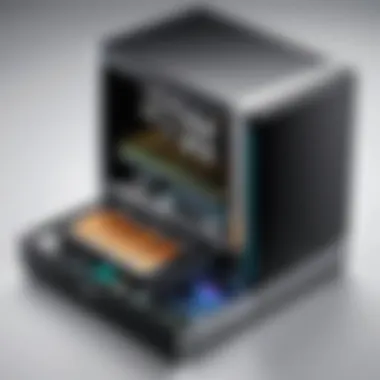Exploring MDisc BDXL Technology: Storage Revolution


Intro
MDisc BDXL technology has gained traction in the realm of digital storage, recognized for its exceptional durability and expansive capacity. As data continues to proliferate across industries, IT professionals must navigate a complex landscape of storage solutions that can safeguard critical information while providing ample space. This article delves into various facets of MDisc BDXL, illuminating its key features and operational nuances to guide informed decision-making in technology selections.
Product Overview
Understanding the fundamentals of MDisc BDXL technology is essential for grasping its potential in data management. MDisc BDXL is designed to withstand environmental challenges, claiming durability that surpasses traditional optical media. This characteristic is vital for organizations that require reliable long-term storage options.
Key Features
- Durability: MDisc BDXL is engineered to resist degradation from heat, light, and humidity. This resilience is crucial for preserving data over extended periods.
- High Capacity: The BDXL format offers a storage capacity of up to 128GB per disc, catering to data-intensive applications.
- Compatibility: MDiscs can be read by standard Blu-ray drives, ensuring a broad compatibility with existing hardware.
- Write-Once Technology: This feature prevents accidental data loss, as information can only be written once.
Technical Specifications
The technical aspects of MDisc BDXL are noteworthy. Here are some specifications that define its capabilities:
- Format: BDXL (Blu-ray Disc eXtended Capacity)
- Storage Capacity: 128GB per disc
- Write Speed: Up to 4x for BD-R
- Read Compatibility: Compatible with VP9 and AVCHD
- Lifespan: Rated for 1,000 years under ideal storage conditions
"MDisc BDXL is a significant improvement over earlier optical storage technologies in terms of both capacity and durability."
Performance Analysis
Examining the performance metrics of MDisc BDXL reveals its standing among other storage media. Performance can vary based on usage scenarios and equipment.
Benchmark Test Results
Benchmark tests show that MDisc BDXL holds its own against traditional storage solutions:
- Read Speed: Comparable to hard drives in certain conditions, particularly in large file transfers.
- Write Speed: Generally slower than solid-state drives, but comparable to conventional Blu-ray discs.
Real-World Usage Scenarios
MDisc BDXL fits various scenarios well:
- Archival Storage: Organizations needing long-term data retention can benefit from its durability.
- Media Storage: Video professionals may find the high capacity advantageous for storing large projects.
- Data Backup: It serves as a robust medium for backing up critical data due to its resistance to environmental factors.
Prologue to MDisc BDXL
MDisc BDXL represents a significant leap in optical storage technologies, offering solutions that meet modern data storage needs. As the volume of digital data continues to exponentially grow, so does the demand for durable, high-capacity storage methods. MDisc BDXL is positioned as a viable option due to its distinctive characteristics, which we will explore further in this section. It combines enhanced storage capacity with superior longevity, making it particularly relevant for IT professionals and tech enthusiasts alike.
Overview of Optical Storage Technologies
Optical storage technologies date back several decades and have evolved substantially over time. These technologies use lasers to read and write data on media such as CDs, DVDs, and Blu-rays. The development of Blu-ray Disc technology ushered in higher storage capacities compared to previous formats, allowing for more efficient storage of large files like 4K videos and extensive data sets.
Key categories of optical storage include:
- CD: Generally holds up to 700 MB.
- DVD: Offers 4.7 GB for single-layer discs and 8.5 GB for dual-layer discs.
- Blu-ray: Standard Blu-ray holds 25 GB for single-layer and 50 GB for dual-layer formats.
- BDXL: Expands this capacity even further with triple-layer discs storing up to 100 GB and quadruple-layer discs reaching 128 GB.


MDisc BDXL builds on the capabilities of conventional BDXL by enhancing durability through unique data-writing techniques. This technology addresses common issues of data degradation found in earlier optical formats, making it appealing for long-term data storage solutions.
Significance of MDisc BDXL in Data Storage
The significance of MDisc BDXL extends beyond its impressive storage capacity. It is designed for long-term archival storage, making it vital for industries where data retention is critical. The technology caters to various sectors, including healthcare, media distribution, and research, where data integrity and longevity are paramount.
MDisc BDXL technology is particularly useful for:
- Durability: Unlike traditional optical discs, MDisc has a unique writable layer that makes it resistant to environmental factors. It can withstand high temperatures, humidity, and exposure to light, which can be detrimental to conventional storage media.
- Capacity: With its capability of storing 100 GB to 128 GB of data, MDisc BDXL allows users to store vast amounts of information securely on a single disc.
- Data Integrity: This technology ensures that data remains intact and readable over time, significantly reducing the risk of archiving failures, which is a common concern with magnetic storage systems.
"MDisc BDXL offers a compelling solution for those seeking reliable long-term optical storage, addressing many challenges posed by previous technologies."
Technical Specifications of MDisc BDXL
The technical specifications of MDisc BDXL are foundational to understanding its capabilities and advantages. These details highlight how MDisc BDXL stands apart from other storage solutions in the market. They also provide insights relevant to IT professionals and tech enthusiasts looking to optimize their data management strategies. Knowing the specifications helps in assessing the technology’s fit for specific needs.
Storage Capacity Analysis
MDisc BDXL discs are designed to offer substantial storage capacity. Each disc can store up to 128 gigabytes of data, significantly exceeding the limits of standard Blu-ray discs. The ability to hold such large amounts of information makes MDisc BDXL ideal for various applications, including media distribution and data archiving. This extensive capacity allows users to consolidate their data storage needs, reducing the number of discs required. This is particularly beneficial for industries dealing with large files, such as video production or scientific research.
A higher capacity not only provides convenience but also enhances cost-efficiency for organizations. When it comes to storage solutions, less often means more. In environments where space is a concern, utilizing fewer discs can lead to better organization and easier retrieval processes.
Data Integrity Features
Data integrity is crucial in any storage medium. MDisc BDXL employs advanced technology to ensure data remains intact over time. The discs use a unique manufacturing process that engraves data into the layers of the disc, providing a more reliable way to maintain information compared to traditional dye-based media. This engravings helps guard against data degradation, ensuring it can be read accurately even after long periods of storage.
Additionally, MDisc technology includes error correction features, allowing for quick identification and correction of any faults that may occur during reading or writing processes. This robustness is vital for users who require dependable performance, particularly in professional environments or where critical data is stored. The integration of these features supports the overall objective of preserving valuable information, making MDisc BDXL a compelling choice for users focused on data longevity.
Physical Durability Factors
The durability of MDisc BDXL is another significant aspect that enhances its appeal. These discs are engineered to withstand a variety of environmental factors that could harm standard optical media. For instance, MDisc BDXL is resistant to scratches, heat, and light exposure, which is a crucial advantage for minimizing potential data loss.
The materials used in the production of MDisc BDXL contribute to its longevity. Unlike traditional discs that degrade over time, MDisc technology can endure harsh conditions, providing a more stable long-term storage solution. Users can feel confident that their data is secure even in less-than-ideal scenarios. This durability makes MDisc BDXL an attractive option for archives and libraries where preservation of information is paramount.
"In environments where data preservation is critical, the enhanced durability of MDisc BDXL can provide peace of mind for users."
Performance Metrics
Performance metrics are central to understanding MDisc BDXL technology. They provide insights into how well this storage medium functions in various practical situations. For IT professionals and tech enthusiasts, data storage decisions rely heavily on these metrics. Thus, thorough knowledge of the performance metrics surrounding MDisc BDXL is invaluable.
Write and Read Speeds
Write and read speeds determine the efficiency of data transfer, impacting usability. MDisc BDXL offers impressive write speeds, often sitting around 4X for 100GB and 6X for 128GB while maintaining stability during retrieval processes. These speeds promote faster backup and archive actions, aiding efficiency in environments where large data sets need quick access. In contrast, traditional Blu-ray technologies generally provide slower read/write capabilities. This performance advantage makes MDisc BDXL a compelling choice, particularly in settings requiring large-scale data handling.
Error Rates and Reliability
Error rates serve as critical indicators of a storage medium's reliability. MDisc BDXL has designed its technology to minimize errors during both writing and reading operations. The inherent stability of the MDisc structure helps reduce the likelihood of data corruption. This reliability factor is crucial for applications requiring high data integrity, such as financial records and medical information. In real-world tests, MDisc BDXL consistently displays lower error rates than conventional storage options, ensuring data remains intact over time. Users prioritize a balance between performance efficiency and error mitigation when decision-making.


Comparative Performance with Other Formats
When analyzing MDisc BDXL alongside other storage mediums like traditional Blu-ray discs or Solid State Drives, several factors arise. For example, while SSDs excel in speed, they can carry limitations regarding long-term data retention compared to MDisc BDXL, which specifically focuses on archival durability. In performance assessments, MDisc BDXL gives a more prolonged lifespan for stored data, positioning it solidly against even high-end alternatives.
In addition, the efficiency of MDisc BDXL is delineated by its capacity to maintain a higher volume of data. This performance metric makes it not just a competitive solution but often a preferred alternative, especially regarded for sustained data retention.
"Understanding the performance metrics is vital for making informed data storage choices. It highlights both strengths and potential weaknesses across formats."
Choosing storage solutions will always present trade-offs. However, having a solid grasp on performance metrics enables a more strategic approach for those in the tech realm, especially when regarding MDisc BDXL.
Applications of MDisc BDXL
The applications of MDisc BDXL technology extend its utility well beyond the average consumer needs. Understanding these applications helps clarify its advantages and significance in the realm of data storage. With growing demands for effective archival and distribution solutions, MDisc BDXL caters to a variety of requirements that are crucial for both individuals and organizations.
Long-Term Data Archiving
One of the primary applications of MDisc BDXL is long-term data archiving. Many businesses face challenges when storing critical information over extended periods. MDisc BDXL offers a reliable solution for archival storage due to its impressive durability and resistance to environmental factors. Unlike traditional optical media, MDisc BDXL ensures that crucial data remains intact for decades. The unique construction of the MDisc layer prevents degradation, making it suitable for important records, historical documents, and even personal data storage.
This also means that organizations can comply with various regulatory requirements for data retention. Utilizing MDisc BDXL for long-term archiving not only ensures data safety but also reduces the risks associated with using hard drives or SSDs, which may fail over time due to mechanical issues.
Media Distribution and Backup Solutions
MDisc BDXL stands out as a viable option for media distribution and backup solutions. Its large storage capacity, which can reach up to 100GB, allows for the storage of high-definition videos and extensive data sets. This feature is beneficial for businesses involved in media production, gaming, and software distribution. Using MDisc BDXL for distributing content ensures that a larger volume is maintained on fewer discs, leading to lower shipping and handling costs.
Furthermore, MDisc BDXL is ideal for backup purposes. Organizations can use it for comprehensive backups of data, which is essential in the event of system failures or cyber threats. In an industry where data loss can lead to severe repercussions, MDisc BDXL serves as an effective backup medium, providing quick retrieval options and reliable data preservation.
Utilization in Professional Environments
In professional environments, MDisc BDXL presents itself as a valuable tool for various applications. Industries such as healthcare, legal, and finance require strict adherence to data integrity and accessibility. MDisc BDXL supports these needs by providing robust storage that is resistant to corruption and physical damage. Professionals in these sectors can utilize MDisc BDXL for storing sensitive information, securing legal documents, or even maintaining patient records.
Moreover, educational institutions can benefit from MDisc BDXL technology for distributing lecture materials and research data. The longevity aspect of MDisc BDXL ensures that educational resources remain available for future generations.
MDisc BDXL technology emphasizes data durability, making it a frontrunner in professional data management solutions.
By exploring the diverse uses of MDisc BDXL, it becomes evident that this technology plays a significant role in the modern landscape of data storage. From securing long-term archives to facilitating professional workflows, MDisc BDXL meets the evolving demands of data management with efficiency and resilience.
Comparative Analysis
The comparative analysis of MDisc BDXL technology offers critical insights into its unique position among various storage solutions. Understanding where MDisc BDXL stands against competitors such as standard Blu-ray discs and traditional hard drives or solid-state drives is paramount for IT professionals. This section aims to clarify the technical advantages and operational efficiency of MDisc BDXL compared to its peers. With the rapid evolution of data management solutions, recognizing these differences allows for better decision-making when selecting storage media that aligns with specific needs.
MDisc BDXL vs. Standard Blu-ray Discs
MDisc BDXL presents substantial advantages over standard Blu-ray discs, notably in durability and longevity. While standard Blu-ray discs typically last for several years under ideal conditions, MDisc BDXL boasts a lifespan of up to 1,000 years when stored correctly. This feature is appealing for applications requiring long-term archiving.
Another key differentiator is storage capacity. Whereas standard Blu-ray can store up to 25 GB per layer, MDisc BDXL accommodates 100 GB on a single disc. Such capacity makes it a superior choice for hefty data storage, including high-resolution media files or large databases.
"MDisc BDXL offers a combination of durability and capacity that standard Blu-ray discs simply cannot match."


Furthermore, MDisc BDXL utilizes a different recording layer technology that can withstand harsh environments, making it less susceptible to scratches and other physical damage that can affect standard discs. This enhanced physical robustness is crucial for certain professional environments where disc integrity is paramount.
MDisc BDXL vs. Hard Drives and SSDs
When compared to hard drives and solid-state drives, MDisc BDXL shines in specific areas. One primary advantage is the lack of power consumption. MDisc BDXL requires no power to maintain data, while both hard drives and SSDs need a constant power supply. This characteristic becomes significant in disaster recovery scenarios, where data preservation is essential.
Both hard drives and SSDs have faster read and write speeds. However, the cost per GB of MDisc BDXL is lower in certain contexts. For example, in long-term data archiving where rapid data access is not necessary, the affordability and durability of MDisc BDXL make it a strong competitor.
In addition, the physical footprint of MDisc BDXL is also an advantage in archival settings. MDisc BDXL can be stored in a compact format, requiring much less physical space than multiple hard drives or SSDs that store similar amounts of data.
Cost Efficiency Assessment
Assessing the cost efficiency of MDisc BDXL is crucial for organizations considering this storage solution. On a surface level, it may appear more expensive than traditional hard drives or standard Blu-ray discs. However, when considering longevity and durability, the initial investment can translate into significant savings over time.
- Long lifespan: With a durability of 1,000 years, MDisc BDXL needs less frequent replacement compared to standard media.
- Reduced storage costs: For sector-specific applications, such as archiving large databases, less physical space and simplified storage management can reduce operational costs.
- Minimal power costs: MDisc BDXL’s passive nature significantly reduces overhead when viewed across several years.
Future of MDisc BDXL Technology
The future of MDisc BDXL technology is of significant importance for both users and developers in the evolving landscape of data storage. With an increase in the data we generate and manage, the relevance of durable and high-capacity storage mediums cannot be overstated. MDisc BDXL provides features that make it a valuable choice for long-term data preservation. Thus, evaluating what lies ahead for this technology will be crucial for stakeholders in IT and related fields.
Expected Innovations and Trends
As technology develops, it is expected that there will be innovations surrounding MDisc BDXL. These advancements may include:
- Higher Storage Capacities: Future iterations of MDisc BDXL may increase the maximum storage capacity beyond current limits. This ability could transform data archiving, enabling users to keep larger datasets on a single disc.
- Enhanced Durability Features: Innovations aimed at further improving the physical resilience of MDiscs can increase their usability in extreme conditions. This could include protection against environmental factors like heat, humidity, and scratches.
- Increased Compatibility: Developments may focus on ensuring that MDisc BDXL is compatible with a wider range of devices. This would help incorporate the format into various existing frameworks in business and consumer environments.
- Integration with Cloud Services: There may be trends toward integrating MDisc BDXL with cloud storage solutions for hybrid data management strategies. This integration can facilitate better data organization and access.
These innovations could position MDisc BDXL as an even more attractive option for users who prioritize reliability and capacity in their data storage choices.
Market Adoption Projections
The market adoption of MDisc BDXL technology is anticipated to grow. As professionals look for reliable solutions, several factors are influencing this trend:
- Growing Data Needs: As organizations continue to produce vast amounts of data, the need for high-capacity storage options will increase. MDisc BDXL, with its substantial storage capability, stands to benefit significantly from this demand.
- Shift Towards Long-Term Preservation: There is a notable shift toward long-term data preservation in various sectors, such as healthcare, education, and media. This trend aligns well with the durability and reliability that MDisc BDXL offers.
- Competitive Pricing: If manufacturers manage to keep costs manageable, this factor may enhance market penetration. The growth in awareness of the MDisc BDXL advantages could lead to broader acceptance among IT professionals and businesses.
- Awareness and Education: As more information becomes available, better understanding of MDisc BDXL's benefits will drive its adoption. Educational initiatives can lead to increased usage in both enterprise and consumer markets.
In summary, the future of MDisc BDXL technology looks promising. Factors such as ongoing innovation and growing market demand will likely define its trajectory in the years to come. Stakeholders within various industries should keep a close watch on these developments to leverage the advantages efficiently.
Ending
In this article, the exploration of MDisc BDXL technology underscores its significance in today's data-driven world. As data storage needs escalate, understanding MDisc BDXL’s specific attributes becomes essential. This conclusion will outline key insights and final considerations regarding MDisc BDXL’s impact on data storage solutions.
Summary of Key Insights
MDisc BDXL stands out for its remarkable storage capabilities, offering up to 128 GB of data retention. Unlike standard Blu-ray discs, MDisc BDXL is built for longevity, resisting environmental damage and ensuring data integrity over time. Key insights include:
- Durability: MDisc BDXL technology is designed to withstand extreme conditions such as temperature fluctuations, humidity, and UV light exposure.
- Data Integrity: Data written on MDisc BDXL maintains its integrity through advanced error correction features that enhance reliability.
- Versatile Applications: It is ideal for long-term archiving, media distribution, and usage in professional environments needing secure data management.
The thorough comparison with other storage formats emphasizes its unique position in the market, particularly for IT professionals who prioritize data preservation.
Final Thoughts on MDisc BDXL
MDisc BDXL represents a pivotal advancement in optical storage technology. Its distinctive qualities make it a suitable option for various data storage needs. The benefits of using MDisc BDXL include a balance of high capacity, durability, and reliability.
As organizations face increasing pressure to manage data efficiently, considering MDisc BDXL is prudent. It not only serves current data storage requirements but also prepares businesses for future challenges.



